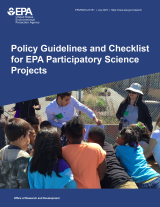Policy Guidelines & Checklist for Participatory Science Projects
This document was prepared to help EPA staff and managers understand key requirements and design considerations for EPA participatory science projects. EPA staff are encouraged to use the content of this document as they design, fund, and manage EPA participatory science projects.
Checklist for Conducting a Participatory Science Project at EPA
This Checklist for Conducting a Participatory Science Project at EPA (pdf) is to be used by EPA staff as they develop a participatory science project to identify which requirements may be applicable to their project based on its characteristics. These requirements were identified based on standard practices across federal agencies and specific experience with EPA-funded projects. This checklist features 17 possible requirements that an EPA participatory science project may need to consider. These 17 requirements are bundled into 14 possible elements of a project (left column). Although any given project may not have all of these elements, all projects will feature the mandatory elements at the top of the checklist.
The table below is an except from the Checklist for Conducting a Participatory Science Project at EPA (pdf).
| ALL EPA participatory science projects will... | Review this section: |
|---|---|
| conduct, communicate, supervise, or use the results of participatory science | EPA’s Scientific Integrity Policy to learn how to adhere to professional values and practices |
| create records | Federal Records Act and FOIA to learn about the collection, dissemination, and management of records |
| collect, produce, or use environmental information | Data Quality Systems and EPA Public Access Policy to understand data quality requirements |
| If your project will... | Then review this section: |
|---|---|
| use participatory science in EPA scientific work | EPA’s Citizen Science Statutory Authority |
| rely on the public to conduct research and/or collect data | Working with Communities to learn strategies on how to carry out a successful participatory science project |
| use volunteers | Antideficiency Act and Volunteer Services to learn when it is permissible to accept voluntary services |
| pose identical or substantially similar questions to 10 or more people | Paperwork Reduction Act – Information Collection Request (Generic Clearance for Citizen Science and Crowdsourcing) to learn requirements for surveying or interviewing large groups of people |
| involve non-EPA partner organizations | Formal Agreements to learn how to appropriately document the relationship |
| collect information about people | Human Subject Research to learn how to safely involve people in your project |
| collect personally identifiable information | Human Subject Research and Privacy Considerations to learn how to safeguard and maintain this information |
| develop a mobile application or public website | Terms of Service and Creating New Apps to make the best choice on which types of applications and products to use |
| use social media or develop EPA communication products | EPA Communication Requirements and Terms of Service to learn about promoting a broad public understanding of the project while using the appropriate products and services |
| disseminate communication material or facts/data to the public | EPA Communication Requirements and Information Quality Guidelines to ensure the quality of information that EPA disseminates |

